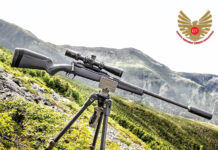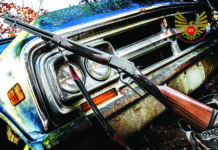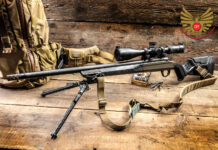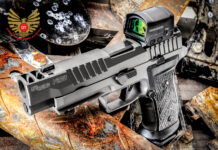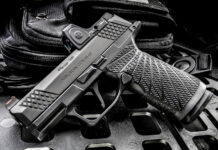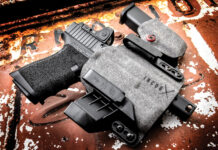
A low cost, high value, high accuracy .22!
First and Second Looks
My first look at the new Victory .22 pistol came at the Smith & Wesson booth at the January 2016 SHOT Show. It was presented as a low-priced but accurate target pistol, suited for competition as well as plinking . . . essentially, an attack on the Ruger Mark I series that has dominated that corner of the market since Ruger introduced it in 1951. Two years later, the late, great Jim Clark Sr. won the National Championships at Camp Perry with one.

This newest S&W .22 is an amalgam of many proven features. A tubular receiver like the Ruger’s, though squared instead of rounded, with a bolt riding therein instead of a slide atop the pistol. A T-shaped grasping apparatus at the rear of the bolt, for the operator to charge the gun or lock it open as needed. The interchangeable but rock-solid-locked-in-place barrel that we first saw on the championship-winning High Standard .22 autoloaders. And an overall shape resembling the iconic Colt Woodsman that debuted over a hundred years ago, but with the pre-WWII Woodsman’s short grip-frame and round butt rendered as a longer round-butt configuration. And, it being 2016, the adjustable sights had fiber optic inserts. The heft in the hand was solid, but certainly not too heavy for an adult shooter with no physical impairment in the upper limbs.
My second look, of course, came when my test sample arrived. The first thing I noticed was that it had a magazine disconnector safety. I’m familiar with the arguments pro and con about this feature. Let me just say that I have no problem with it.

The test gun’s trigger pull averaged 3.54 pounds when weighed from the toe (the bottom end of the trigger), and 4.62 pounds when measured from the center of the trigger. The distinction is important, because a pivoting trigger as on this pistol (as opposed to a sliding one, like on a 1911) brings leverage into play. The trigger pivot point is the fulcrum, and the farther away from it the finger is, the more leverage the pulling finger has, and therefore the less effort is required to fire the gun. The center of the trigger, however, is where the finger normally rests, and this writer for one believes that is the relevant place for measurement. However, the firearms industry (and plaintiff’s experts in civil lawsuits) don’t always agree on that.
There’s a little bit of “backlash” on the Victory’s trigger as it comes out of the box; that is, once the sear breaks and the shot is underway, there’s some free movement of the trigger that can let the trigger finger slam it back against the frame, causing some movement of gun and sights in the instant before the bullet leaves the muzzle. S&W’s engineers have allowed for that, with an adjustable trigger stop built into the trigger itself. The people who designed this gun were apparently serious about good, deliverable accuracy.
Accuracy
I went with my usual testing protocols. Concrete bench with Caldwell Matrix rest. 25 yards. Measuring each 5-shot group center to center to the nearest 0.05” between the farthest apart shots, then doing that again for the best three hits in the same group. Rationale: the first shows what a small game hunter can expect taking a solid rest and keeping his or her cool at the same distance. The second, “best three” group reflects the fact that over the decades, I’ve found that if there were no “called flyers” (where the shooter knew he pulled a shot), the best three from a solid bench rest would typically equal what all five of the same rounds from the same gun could be expected to deliver from a machine rest. “Practical accuracy” vis-à-vis “mechanical accuracy,” as it were.

While we’re on the topic of semantics, there are two kinds of accuracy. One is how close the gun shoots to the point of aim, and that’s up to those responsible for sighting it in and establishing “zero.” The other is the precision element: how tightly do those shots group together, assuming the same point of aim for all? That’s the responsibility of those who made the gun.


